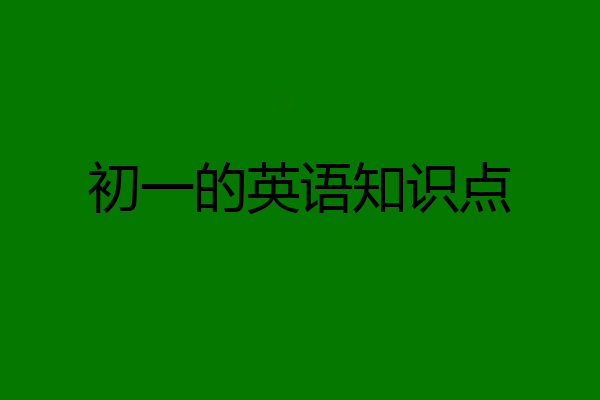
胖哥high吃
学好英语首先是知识点的整理,下面总结了初一英语重点知识点,希望能帮助初一学生学习英语。
1、三种人称:第一人称(I, we),第二人称(you, you),第三人称(he, she, it)。
2、人称代词的主格,即人称代词位于句子主语位置时的形态:I, We, You, You, He, She, It
3、人称代词的宾格,即人称代词位于句子宾语位置时的形态:me, us, you, you, him, her, it。
4、形容词性物主代词:my, our, your, your, his, her, its, their。
5、名词性物主代词:mine, ours, yours, yours, his, hers, its, theirs。
6、反身代词:myself, ourselves, yourself, yourselves, himself, herself, itself, themselves。
1、形容词性物主代词相当于形容词,只能修饰名词,作定语。
注意:
①在汉语中,表示“……的”可以省略,但在英语中必须用形容词性物主代词
②名词前面已经有形容词性物主代词修饰时,不能再用冠词或指示代词修饰
③若名词前已经有形容词性物主代词修饰,再需要其他形容词修饰时,需放在物主代词之后
2、名词性物主代词相当于名词,在句子中作主语、宾语或表语
注意:
①名词性物主代词作主语时,谓语动词的单复数形式取决于它所代替的名词的单复数形式
②在做句型转换时,对两类物主代词提问都用whose, 但是形式有所不同。
③名词性物主代词可以和of构成双重所有格,而形容词性物主代词不能。
can+动词原形,它不随主语的人称和数而变化。
1、含有can的肯定句:主语+can+谓语动词的原形+其他。
2、含有can的否定句:主语+can't+动词的原形+其他。
3、变一般疑问句时,把can提前:Can+主语+动词原形+其他? 肯定回答:Yes,主语+can。否定回答:No,主语+can't.
4、含有can的特殊疑问句:特殊疑问词+can+主语+动词原形+其他?
I can speak English.→I can't speak English.→Can you speak English? →What can you speak?
介词短语的构成:介词+the / 物主代词/名词所有格+名词等。
1、在介词短语中,定冠词the常常不翻译成中文,但the不能省略,是表示特指的。
2、若介词短语中名词前用了物主代词或名词所有格时,不能再用定冠词the,但名词所有格前可以用the。
3、专有名词前不能用the。
4、表示方位的介词:on, in, behind, between,under等。
on在……上面(紧贴着某物,有面的接触)in 在……里面;behind在……后面;between在……之间,常于and连用;under在……的下面。


冷火秋烟
对一些重要的知识点进行 总结 有助于我们针对性地学习初一英语。接下来是我为大家带来的初一英语重要的知识点大全,供大家参考。
I. 重点短语
1. Sit down
2. on duty
3. in English
4. have a seat
5. at home
6. look like
7. look at
8. have a look
9. come on
10. at work
11. at school
12. put on
13. look after
14. get up
15. go shopping
1. Let sb. do sth.
2. Could sb. do sth.?
3. would like sth.
4. would like to do sth.
5. What about something to eat?
6. How do you spell …?
7. May I borrow…?
1. -Thanks very much!
-You're welcome.
2. Put it/them away.
3. What's wrong?
4. I think so.
I don't think so.
5. I want to take some books to the classroom.
6. Give me a bottle of orange juice, please.
Please give it / them back tomorrow. OK.
9. What's your favourite sport?
10. Don't worry.
1.人称代词的用法;
2. 祈使句;
3. 现在进行时的构成和用法;
4.动词have的用法;
5.一般现在时构成和用法;
6.可数名词和不可数名词的构成和用法
1. That's right./ That's all right./ All right.
That's right意为"对的",表示赞同对方的意见、看法或行为,肯定对方的答案或判断。例如:
"I think we must help the old man.""我想我们应该帮助这位老人。"
"That's right."或 "You're right.""说得对"。
That's all right.意为"不用谢"、"没关系",用来回答对方的致谢或道歉。例如:
"Many thanks." "That's all right."
"Sorry. It's broken." "That's all right."
All right.意为"行了"、"可以",表示同意对方的建议或要求。有时还可以表示"身体很好"
"Please tell me about it." "请把此事告诉我。"
"All right.""好吧。"
Is your mother all right?你妈身体好吗
2. make/do
这两个词都可以解释为"做",但含义却不同,不能混用。make指做东西或制东西,do指做一件具体的事。
Can you make a paper boat for me? 你能为我做个纸船吗?
He's doing his homework now.他正在做他的作业。
3. say/speak/talk/tell
say:是最口语化的最普通的一个词,意为"说出"、"说道",着重所说的话。如:
"I want to go there by bus" , he said . 他说,"我要坐汽车到那里去。"
Please say it in English .请用英语说。
speak : "说话",着重开口发声,不着重所说的内容,一般用作不及物动词 (即后面不能直接接宾语 ) 。如:
Can you speak about him? 你能不能 说说 他的情况?
I don't like to speak like this. 我不喜欢这样说话。
speak 作及物动词解时,只能和某种语言等连用,表达在对话中恰当使用词汇的能力。如:
She speaks English well.她英语说得好。
talk : 与 speak 意义相近,也着重说话的动作,而不着重所说的话,因此,一般也只用作不及物动词, 不过,talk 暗示话是对某人说的,有较强的对话意味,着重指连续地和别人谈话。如:
I would like to talk to him about it . 我想跟他谈那件事。
Old women like to talk with children.老年妇女喜欢和孩子们交谈。
tell : "告诉",除较少情况外,一般后面总接双宾语。如:
He's telling me a story.他在给我讲 故事 。
tell a lie 撒谎
tell sb. to do sth. /tell sb. not to do sth.
Miss Zhao often tells us to study hard.
4. do cooking/ do the cooking
do cooking 作"做饭"解,属泛指。do the cooking 特指某一顿饭或某一家人的饭。cooking为动名词,不能用作复数,但前面可用 some, much修饰。从do some cooking可引出许多类似的短语:
do some washing 洗些衣服
do some shopping 买些东西
do some reading 读书
do some writing 写些东西
do some fishing 钓鱼
从以上短语可引申出另一类短语,不能用some, much或定冠词。
go shopping 去买东西
go fishing 去钓鱼
go boating 去划船
go swimming 去 游泳
5. like doing sth./ like to do sth.
like doing sth. 与like to do sth. 意思相同,但用法有区别。前者强调一般性的 爱好 或者表示动作的习惯性和经常性;后来表示一次性和偶然性的动作。例如:
He likes playing football, but he doesn't like to play football with Li Ming.
他喜欢踢 足球 ,但是他不喜欢和李明踢。
6. other/ others/ the other/ another
other表其余的,别的,
Have you any other questions?你还有其他问题吗?
others 别的人,别的东西
In the room some people are American, the others are French.在屋子里一些人是
美国人,其他的是法国人。
the other表另一个(二者之中)one…,the other…
One of my two brothers studies English, the other studies Chinese.
我两个哥哥中的一个学习英文,另一个学中文。
another表三者以上的另一个,另一些
There is room for another few books on the shelf.书架上还可以放点书。
7. in the tree/ on the tree
in the tree 与 on the tree.译成中文均为"在树上"但英语中有区别。in the tree表示某人、某事(不属于树本身生长出的别的东西)落在树上,表示树的枝、叶、花、果等长在树上时,要使用on the tree.如:
There are some apples on the tree. 那棵树上有些苹果。
There is a bird in the tree. 那棵树上有只鸟。
8. some/ any
(1)some和 any既可修饰可数名词,也可修饰不可数名词。但有以下两点需要
注意。
some常用于肯定句中,any常用于否定句和疑问句中。如:
There is some water in the glass.
Is there any water in the glass?
There isn't any water in the glass.
优质英语培训问答知识库